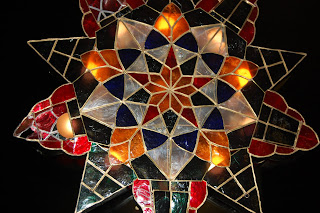
Tiny parol lights beckoned from the 2nd floor window panes as favorite Pinoy carols drifted from the Pryzbyla University Center of the Catholic University of America campus in Washington DC – ushering what Paskong Pinoy organizers declared the season of unity and compassion for Filipino-Americans in the region.


The wind chill sent the mercury falling but it didn’t stop Fil-Ams from joining the festivities.
“This is the biggest Christmas gathering for Fil-Ams in our area,” explained Bobby Tamayo.


Much of the legwork – including teens shivering in the cold holding signs directing people to the Christmas concert – was done by young students belonging to the Filipino Organization of Catholic University Students (FOCUS).

The Paskong Pinoy, virtually a Fil-Am institution in the Metro DC area, is a yearly project of the Philippine American Foundation for Charities (PAFC) and the Philippine Embassy.
They are supported by groups like the Catholic University of America, Tau Gamma Phi and the Alpha Phi Omega alumni association in Washington DC (APODCAA).
Ambassador Willy Gaa said Paskong Pinoy was a way to keep Pinoys in the American capital region connected with their roots, as well as keep the “Old Country” traditions alive for succeeding generations.

Some American students watched the show to learn a little more about their Fil-Am classmates.
Ambassador Constancio Pinto of East Timor, the only other predominantly Christian nation in the Western Pacific aside from the Philippines, brought his son to the show.

A total of 11 artists and groups performed in this year’s Paskong Pinoy – from soloists Ernest Zalamea, an opera performance sophomore in CUA, and Elisabeth Carlton of Richmond to a children and teens vocal and dance ensemble that easily stole the show by gamely finishing their rendition of Pasko na Naman even after the canned musical accompaniment conked out.

“Isn’t it the case that our children do what their parents wanted to do but didn’t get a chance,” Dr. Jun Quion asked, as he and wife Nathalie, also a physician, beamed after the performance of the Quion Quintet.
All their children – Justin Michael, Alexander Philip, Christopher James, Patrick Anthony and Katherine Michelle, ages 10-17 – performed a cut from Tchaikovksy’s Nutcracker Suite on violin and cello.
The Filipino Ministry Choir of St. Columba sang Simbang Gabi while the Young Adults Choir of St. Columba did their version of Light of a Million Mornings and the Jingle Bells Calypso.

The Medical Mission of Mercy USA Choral Group sang a medley of Namamasko, Kami Po’y Paskuhan and Noche Buena.
Members belong to the Philippine-American Medical Mission of Washington DC that conduct yearly free medical work in the Philippines at their own expense.
Not to be outdone, the Filipino Teachers Choir, composed of Filipino educators in Prince George’s County and the Washington DC school districts, delivered their version of You Raise Me Up and Pastol, Pastol Gumising.
The Showpow rendered their version of Carol of the Bells and Season of Love. The group spun out of YO-YO Inc. and is made up mostly of 2nd and 3rd generation Fil-Ams who say they're bound by a common passion to preserve Philippine culture through the performing arts.

The Northern Virginia Rondalla, which opened the show, has been a fixture in Paskong Pinoy since 2005.
Although it originated in medieval Spain, the Philippine rondalla is considered unique partly because of the use of locally crafted stringed instruments like the shorter-necked Philippine bandurria.

The Tanghalang Pilipino and Friends Angklung Ensemble performed Himig Pasko, Pasko na Sinto Ko and Kling, Kling, Kling through a combination of song and playing the angklung, a bamboo-based instrument indigenous to Southeast Asia.
The Tanghalang Pilipino was formed in 1984, performing to mainstream audiences to pursue their goal to pass along the rich Filipino heritage to future generations.
No comments:
Post a Comment